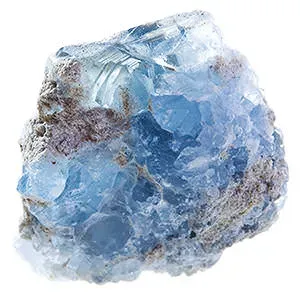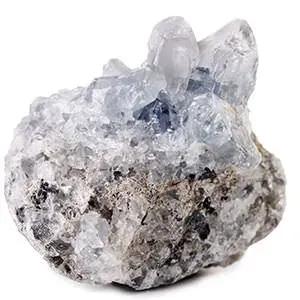 Celestine can be many different colors, however its name derives from the Latin caelestis, which means celestial, referring to the pale, sky blue color of some crystals. Celestine is also sometimes known as celestite. It is a mineral that is used for jewelry, but more often, it is used for various industrial purposes. The powdered form of celestine gives off a bright red flare when burned. As such, it is used as a source of strontium for flares and fireworks. Celestine is also used to make glass, ceramics, paint, and rubber. Furthermore, it is used as an additive to battery lead, as well as to refine sugarbeet. Celestine is most often colorless, but can be red, orange, yellow, milky white, or pale blue. The most highly prized variety of celestine is blue. Celestine is extremely fragile, having perfect cleavage and rating only a 3.5 on the hardness scale. It is therefore not cut very often, though some extremely beautiful cut specimen can be seen in museums and private collections.
Celestine can be many different colors, however its name derives from the Latin caelestis, which means celestial, referring to the pale, sky blue color of some crystals. Celestine is also sometimes known as celestite. It is a mineral that is used for jewelry, but more often, it is used for various industrial purposes. The powdered form of celestine gives off a bright red flare when burned. As such, it is used as a source of strontium for flares and fireworks. Celestine is also used to make glass, ceramics, paint, and rubber. Furthermore, it is used as an additive to battery lead, as well as to refine sugarbeet. Celestine is most often colorless, but can be red, orange, yellow, milky white, or pale blue. The most highly prized variety of celestine is blue. Celestine is extremely fragile, having perfect cleavage and rating only a 3.5 on the hardness scale. It is therefore not cut very often, though some extremely beautiful cut specimen can be seen in museums and private collections.
 When celestine is cut, it is usually given brilliant or mixed cuts, however cut pieces lack any sort of fire. Celestine is a transparent or semi-translucent crystal with a vitreous to pearly luster. It has often been mistaken for baryte as the two minerals form very similar crystals and share the same structure. However, burning each mineral can quickly distinguish the two. As mentioned earlier, when celestine is burned, the flame color is red. However, when baryte is burned, the flame color is a pale green. This is the best way to identify each stone. Celestine is usually found as crystals, or fine-grained masses. It occurs in evaporate deposits in pegmatites with sandstone or limestone and also occurs in cavities in volcanic rock, or in mineral veins. It is found in association with galena, baryte, gypsum, halite, anhydrite, calcite, dolomite, fluorite and sphalerite.
When celestine is cut, it is usually given brilliant or mixed cuts, however cut pieces lack any sort of fire. Celestine is a transparent or semi-translucent crystal with a vitreous to pearly luster. It has often been mistaken for baryte as the two minerals form very similar crystals and share the same structure. However, burning each mineral can quickly distinguish the two. As mentioned earlier, when celestine is burned, the flame color is red. However, when baryte is burned, the flame color is a pale green. This is the best way to identify each stone. Celestine is usually found as crystals, or fine-grained masses. It occurs in evaporate deposits in pegmatites with sandstone or limestone and also occurs in cavities in volcanic rock, or in mineral veins. It is found in association with galena, baryte, gypsum, halite, anhydrite, calcite, dolomite, fluorite and sphalerite.
 High quality Celestine, suitable for cutting for jewelry, is found in Namibia and Majunga, in Madagascar. Fine celestine is also mined at Hastings County, Ontario and Lower Saxony, Germany. The highly coveted blue crystals so prized by collectors, are found in Gloucestershire, England, and Agrigento, Sicily, in Italy. Exceptionally large crystals can be found along Lake Erie, especially at Put-In-Bay, in Ohio. Celestine of slightly lower value can be found in other locations around the world, including Czechoslovakia, Egypt, France, Mexico, Tunisia, Peru, Poland, and Libya. Celestine can also be found in various locations around the United States, including Monroe County, Michigan, Bell's Mill, Pennsylvania, Clay Center, Ohio, Death Valley, California, and Jefferson County, New York.
High quality Celestine, suitable for cutting for jewelry, is found in Namibia and Majunga, in Madagascar. Fine celestine is also mined at Hastings County, Ontario and Lower Saxony, Germany. The highly coveted blue crystals so prized by collectors, are found in Gloucestershire, England, and Agrigento, Sicily, in Italy. Exceptionally large crystals can be found along Lake Erie, especially at Put-In-Bay, in Ohio. Celestine of slightly lower value can be found in other locations around the world, including Czechoslovakia, Egypt, France, Mexico, Tunisia, Peru, Poland, and Libya. Celestine can also be found in various locations around the United States, including Monroe County, Michigan, Bell's Mill, Pennsylvania, Clay Center, Ohio, Death Valley, California, and Jefferson County, New York.
 Medically, Celestine can help many different ailments. It treats disorders of the eyes and ears, and soothes muscle tension and headaches by calming both the mind and the body together. Celestine also eliminates toxins in the body. Mentally, celestine brings an overall calm and balance. It encourages inner peace, sleep, and powers of compassion, love, friendship, fertility, growth, spirituality and reconciliation. It is also useful for remembering dreams and has always been thought to attract good fortune. Celestine is thought to be a great stone for creative people, as it aids in helping the wearer to access his intuitive creativity. It also encourages a great openness to new experiences, helping the wearer rid the fear that may come along with such experiences.
Medically, Celestine can help many different ailments. It treats disorders of the eyes and ears, and soothes muscle tension and headaches by calming both the mind and the body together. Celestine also eliminates toxins in the body. Mentally, celestine brings an overall calm and balance. It encourages inner peace, sleep, and powers of compassion, love, friendship, fertility, growth, spirituality and reconciliation. It is also useful for remembering dreams and has always been thought to attract good fortune. Celestine is thought to be a great stone for creative people, as it aids in helping the wearer to access his intuitive creativity. It also encourages a great openness to new experiences, helping the wearer rid the fear that may come along with such experiences.